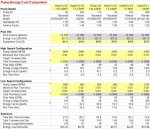I am looking for a new pump. I used Mark's spreadsheet to compare the various options. To try to make a fair comparison, for the VS pumps I plan to run them at 2 hours a day at a higher flow rate (~45gpm), and the remaining time at a lower flow rate (~20gpm). The higher flow rate would be to run my heater. For the 2-speed pump I assumed it would run 0.5 hours a day at high speed and the rest of the time on low speed. For all the pumps I targeted 1 turnover per day (which I know might be high, but seemed reasonable).
A few questions I have:
1. Why is there such a large difference in energy cost between the two MaxFlo VS pumps?
2. Is the Tri-Star really that much better than the other VS pumps?
3. Anyone have experience with the Tri-star in terms of reliability, etc...?
A few questions I have:
1. Why is there such a large difference in energy cost between the two MaxFlo VS pumps?
2. Is the Tri-Star really that much better than the other VS pumps?
3. Anyone have experience with the Tri-star in terms of reliability, etc...?



